
Lots of people hate conceptual art. It’s really quite remarkable, and possibly unfortunate. Ostensibly, artists make art to engage, entertain, and inform people, in which case hatred is an extreme response. Though it does occur to me that the kind of art that is most disliked might be the variety that tries to “challenge” the presumed assumptions of a less aware audience. But first, let’s look at a couple rants against conceptual art I’ve seen recently.
Conservative YouTube commenter Paul Watson’s attack on “Modern Art” received over 22,000 likes. In it he accuses:
Modern, or “conceptual art” isn’t art at all. It’s one big circle jerk of pretentious twats trying to make themselves look sophisticated by ascribing meaning to something that’s completely meaningless… Why is it that the most talent-less and vacuous shit gets promoted by the art establishment? Well, it’s partly born out of elitism. If the artistic merit of a bunch of squiggly lines can only be appreciated by a select number of privileged insiders they can sneer at the uninitiated, and justify their own intellectual superiority.
When you see someone intently staring at a Jackson-Pollock-style vomit canvas they’re not really trying to ascertain its deeper meaning. It’s all just an act to prove to the other pompous wankers that they’re part of the same cult of aesthetic relativism, while sneering at the Philistine general public who just don’t get it, despite the fact that there’s nothing to get.

Shortly after that colorful outburst, and a few examples, he devolves into his usual conservative tirades about “leftists”, “social justice warriors”, and gender identification. The cherry on top is a kiss of possible Islamaphobia, as he taunts that if people really want to be offensive, they should draw “life-sized cartoons of Mohammad”. He concludes:
Conceptual art is shit. It doesn’t enrich our culture: it degrades and cheapens society by exulting the vulgar, the crass, and the scatological. And the people promoting it are preventing us from enjoying modern art produced by artists with actual talent. Those people are contemptible, regressive, twats, who should be ostracized, shamed, and left alone to play with each other’s poo while genuflecting over its artistic brilliance.
If it were a parody, Watson’s own video might qualify as a hot piece of conceptual art. But, of course it is not, and the video only has 1,500 dislikes (7%), one from yours truly. While I sort of enjoyed his rant against the theoretical excesses of conceptualism, his staunchly conservative politics can be difficult to stomach.
But it’s not just conservative blow-hards who abhor conceptual art. Joe Rogan – of Fear Factor, UFC, and stand up comedy fame – can be somewhat reasonable and very intelligent in his lengthy podcasts, while also being a Bernie supporter (Watson’s for Trump), but only had the worst invective for conceptual art. About the Los Angeles County Museum of Art, he opined:
That place is dog shit. It is one the the worst museums I’ve ever been to in my entire life… Well, I went with my kids ’cause I thought it’d be fun to take the kids to the art museum. My kids love art, and they could see some cool paintings and shit. And I knew we were fucked when we first got there because we walked into this room, and it looks like there are these curvy walls, and I felt like you go inside the curvy walls and there’s probably some cool paintings. NO! The curvy walls were the fucking art. And I went, “Noooooo. We’re fucked! It’s one of THESE places. And there were all these super pretentious people. They were like, please don’t touch that. Everyone you go they’re like, “don’t touch, don’t touch, don’t touch”.
I’m not sure what Joe expected to see, because one of his daughters was five, and I can’t imagine bringing a five year old into ANY museum and expecting her to be entertained. Kinda’ think he should have gone to the petting zoo instead.
The “curvy wall” was Richard Serra’s Band.
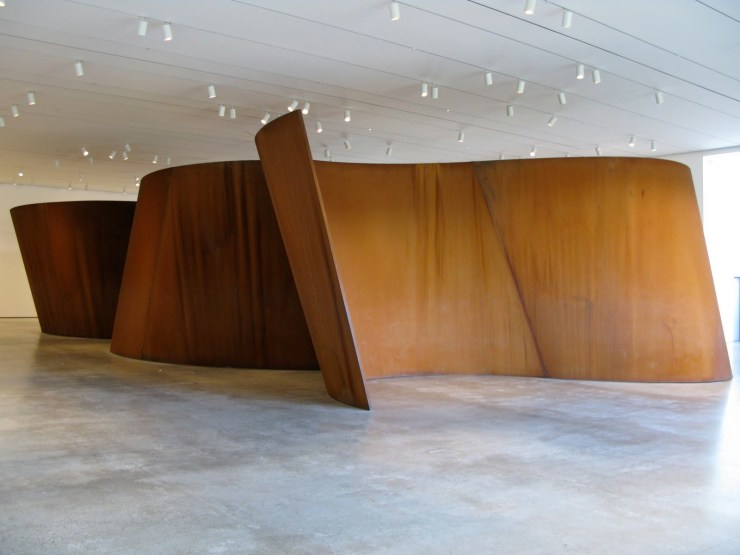

The LACMA, also, what is that a rock they have there? I wanna’ fuckin’ hit somebody. God dammit.
He lamented that they played Jazz, “which is my other least favorite thing”, and bundled it all up thusly:
It’s like super-pretentious meets uber-pretentious, and they collide in a fucking shit-storm of hipster. Oh my God, it was so gross.
I’m confident I’m a big fan of a lot of art Watson and Rogan would shit on, perhaps including my own, but I almost regret to admit that I have some of the same reservations about some of the same conceptual work that they do [I like Serra, and certainly Pollock, but the vomit canvases are thin gruel.] . So, let’s explore what’s so enervating about conceptual art that it can seriously piss people off.
There are a few good reasons good people hate conceptual art. One is the rivalry between conceptual art and painting, in which conceptual art arrogantly and infuriatingly positions itself as automatically superior. Another is conceptual art’s presumption that it breezily launches interventions into art history, thus changing the course of art history, changing the way we see art, and even the way we SEE. Lastly is the uninspiring witty artifacts of these assumed great artistic upheavals, which, taken out of an artificial intellectual context in which they gain art historical importance, revert to innocuous objects: a urinal; vacuum cleaners in a glass case; cheese graters on a shelf; a neon sign; an LED sign; a stack of paper… There is excellent “conceptual” (non-traditional, new media) art which I will cover in a future article in this series, but it tends to be the kind that aspires to do something amazing with unconventional means and mediums, rather than the kind that tries to change the course of civilization with a (usually cynical) gesture.
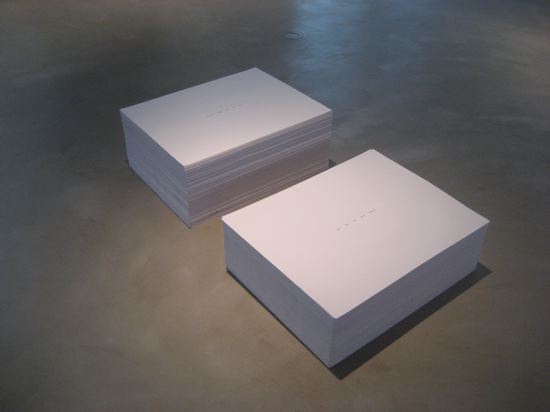
If you think I’m opinionated, see my codicil at the bottom of this post.
I have no problem with conceptual art itself, unless it’s just a bad example of it. I prefer to live in a world with conceptual art in it, including the likes of Koons and Hirst, who I have lampooned in the past. In the case of those two characters, it’s just their astronomical fame and fortune – when most artists only dream of being able to continue making art at all – combined with the absence of traditional skill, substance, or obvious sacrifice in the work, which adds injury to insult. The art itself is an addition to life, at least something to ponder on a lunch break.
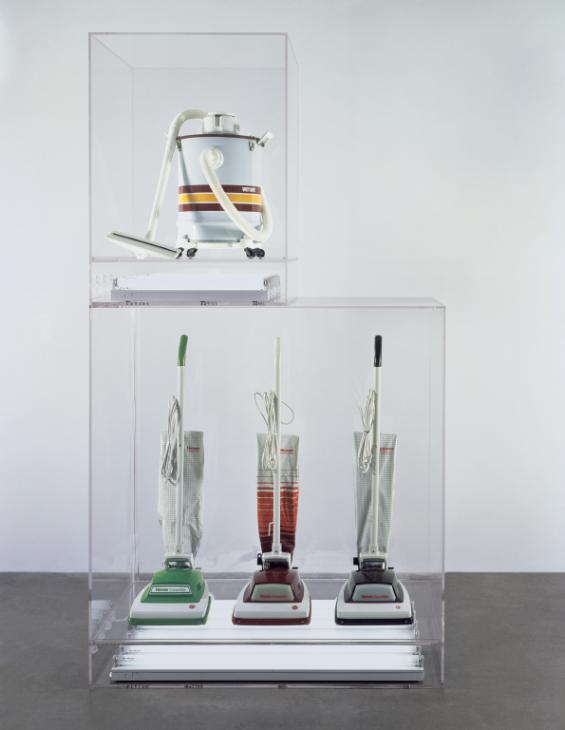
The first thing we need to come to grips with is that the animosity between conceptual art and painting issues from both sides of the spectrum, and reflects the claim of one or the other to be the real or superior art. We tend to think this attack comes from painting – y’know, those crusty, ass-backwards white male fucks who can’t handle that they are no longer relevant and their avowed lofty art is just noodling with pigment. By Gad, they are painting their own epitaphs! I’m not saying those guys don’t exist. I’ve had my run-ins with them while walking the gauntlet of art school. I was kicked out of an oil painting class (at a community College) on the first day for questioning the teacher when he tried to impress us with paintings by Bouguereau. Sure, I was being a bit of a smart-ass. I remember what I said: “Isn’t Bouguereau the artist the Impressionists most detested?” He’d also annoyed me while he was trying to seduce the girls by drawing a caricature of himself as a fox on the blackboard (get it, a “fox”, as in “foxy”, as in “I sleep with my students,” or would if I could). I got to walk out as he heaped insults on me about how I was too good to be in his class, and while my peers applauded. Sure, there are those conservative painters of nudes and still-lifes who defensively reject competing approaches, but they don’t even like Francis Bacon. Later, I found out from a teacher I got on well with that I only got a constellation prize in the yearly art exhibit because, “one teacher was opposed to your work”.
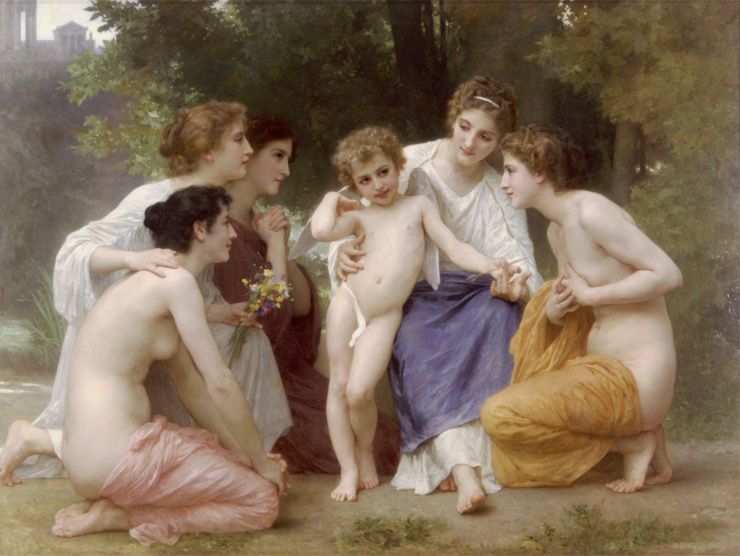
Ah, shit, I just remembered a similar drawing teacher who taught us how to draw auras, which he claimed he could see (to impress the girls), and who showed us paintings by Bacon in order to tell us what a “sick puppy” he was. I dropped out of that class, and that school (Northridge). When I brought in the slip he had to sign so I could eject myself from his class, he called me a “turkey”. My peers laughed, again. There are those sorts of barnacled dinosaurs who oppose anything non-traditional, but generally speaking the antagonism issues from the conceptual art side.
Conceptual art sets itself up as having evolved out of painting, and triumphing over it, rendering painting if not moribund only relevant to the degree it matters within a conceptual paradigm. I base this conclusion largely on my own art education through graduate school, what we read and discussed, and how art was assessed in endless hours of critiques. [Note that I entered art school as a painter, but made all kinds of art, including performance and installation, and received a $10,000 fellowship while a senior doing my undergraduate work, based on a juried exhibit, which was only awarded to one student per grade. My master’s thesis was an installation which my thesis committee reacted very favorably to. I mention this so people don’t automatically assume I’m an angry paint dauber who is clueless about conceptual art.] What I experienced in art school is the same thing I encounter all the time reading art journals (such as Hyperallergic), and in discussions and debates with others, including in comments here.
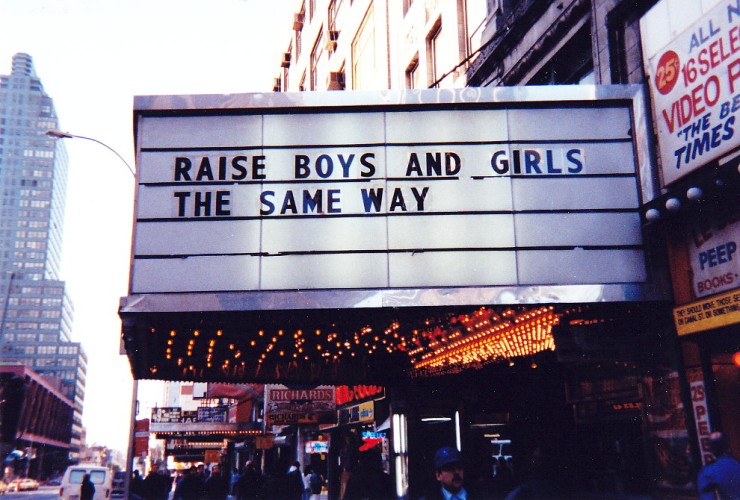
In the conceptual art paradigm all art is reduced to ideas and purposes, and often political ones. I wrote about this in relation to Jackson Pollock in part 3 – How art history got Jackson Pollock all wrong, and why it matters. In a nutshell, Pollock is seen as the pioneer of “action painting”, and as important for innovating that breakthrough. This is turning art on its head because it puts art in the service of an idea, rather than the idea being an impetus, probably among several others, for making visually captivating images. A painting is no longer worth a thousand words: it’s a vehicle for sharing a one-liner.
Imagine this scenario. All the bullshit theory about music became more interesting and important than actually listening to the music. Theory about music started to dictate music and musicians followed the new rules. Out of this transformation, musicians began to make theoretical music, which appealed more to everyone who appreciated theory more than music.
Somehow in that context conceptual art becomes preposterous, and might actually be why conceptual music hardly exists, and is listened to even less.
Visual art is traditionally created to be looked at, and it’s intended for people who like looking at images. Don’t get upset. I’m not saying anything that isn’t painting isn’t art, I’m just saying if it isn’t about the visual experience, than it’s not visual art. You can compare this to music, which is intended to be listened to. If I want to listen to music, I will seek out the branch of art that is created in order to be savored aurally – music. Similarly, if I want to relish imagery, I will search for art which was intended to be visually satisfying. Traditional visual art uses line, color, form, movement, composition, and so on, just as traditional music uses melody, harmony, rhythm, choruses, and polyphony… If I want to listen to music, I’m not going to go sit across from Marina Abramović, and gaze into her eyes. If I want to relish visual imagery, I’m not going to go read a text by Jenny Holzer, as I could have virtually the same VISUAL experience, only better, by walking around Time Square. But if I want to see another kind of art that isn’t visual art or music, I might go to a performance or installation… This is all perfectly obvious. Where it gets confusing is music and conceptual art are properly seen as unique art forms, as different as apples and oranges, but visual art and conceptual art are somehow lumped together as bananas.
Because I’ve done conceptual art, including installation, performance, site-specific art, and text-based art, as well as lots of drawing and painting, I can easily see that they are very different disciplines, though each has an element of creativity. They are as different as playing the clarinet and writing a short story. I use this example because when I was in High School I played the clarinet in band (crappy choice of instrument), took drawing classes, and had a creative writing class. I was pretty good at all of those things, and never supposed that one art form was greater than another. I figure a lot of people had similar experiences and can easily relate. So then, I assume, you can just tap into your own experience in school, think about painting and conceptual art in this way, and see they are inherently different.
The only way to lump painting in with conceptual art under the umbrella of “visual art” is to do it within a conceptual framework, in which anything can be art, and painting is just one (inherently limited) kind of practice. Painting is thus judged by the standards which apply to conceptual art: apples are judged as inferior oranges. From this perspective, painters can be conveniently dismissed as, to quote my infamous “new genre teacher”, Paul McCarthy, “locked in the rectangle”.
I remember this phrase very clearly because he once accused me of it when I was his student in “New Genre” (which he mispronounced with a hard “j”). By this point I’d already had a painting teacher tell me I’d never make it to grad school, and was well fed up with teachers who, to quote my favorite failed president, “misunderestimated” me, in their glaring arrogance. In order to disprove his blanket dismissal of me as hopelessly behind and only able to make marks within a rectangular canvas, before the next class I created a large wooden rectangle, which a person could be locked into, standing up, and had myself locked into it, naked, on the 4th floor of the art building, facing the elevators. Locked in the rectangle, my ass! I’d lost respect for McCarthy early on in the term, and he’s never regained it, except perhaps for those mechanical Bushes, sodomizing pigs, which is just too fucked up to not acknowledge the diabolical brilliance of.

I’m going to dwell on McCarthy a bit because not only is he an art star, but since he was one of my teachers, he represents an art paradigm I was directly exposed to in academia, in which case I can quote what he said while I was a budding artist, and before I was ultimately thwarted in grad school because of my DNA (straight white males do not deserve art careers unless they are devoted to deconstructing their own white male privilege). From McCarthy’s enlightened perspective, filling your underwear with condiments and feigning masturbation, or doing it, becomes free and unconstrained because it is not painting.
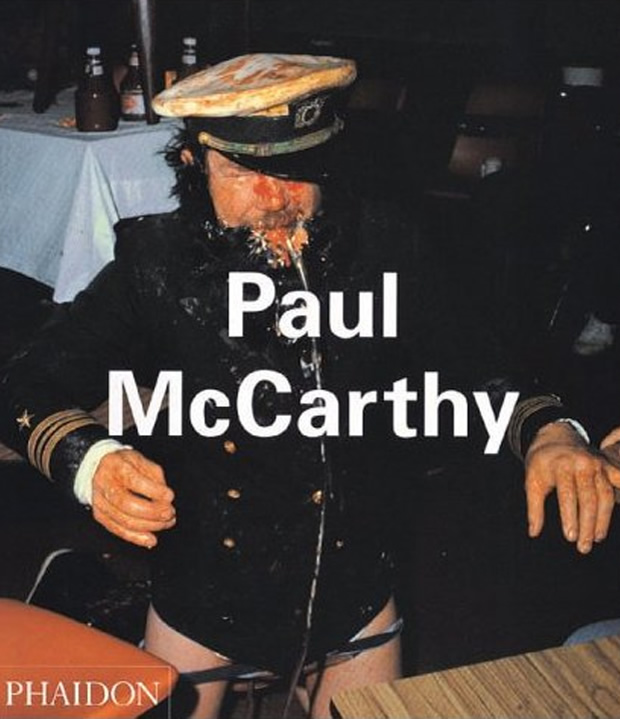
Ironically, sticking a Barbie doll slathered with mayonnaise up your ass is liberating – he did that, er, in a hotel lobby – and painting automatically makes you anal. This is like saying that musicians are “circumscribed by the score” while blowing sounds like elephant farts through an amplified garden hose, or deriding novelists as “closed in the book” while writing text on your ball-sack with an indelible marker. It is, again, the befuddled misapplication of standards appropriate to one genre to an unrelated other. Keep in mind that if we believed that visual art had been derailed by conceptual art, and we can never go back, than there would be nothing inherently visually interesting being created, nothing to really look at. This is as ridiculous and desirable as if we’d stopped music in the 60’s, and declared it irrelevant because it only functioned in an aural dimension and in accordance with musical structures evolved in the patriarchy.

Some painters could be tolerated and humored, if, say, for example, the painter was a woman and painted vaginas as a form of feminist statement. The painting would have to be justified as an “intervention” in art history: some sort of feminist hijacking of masculine media in order to subvert it. The only way to paint is to do so in such a way that you deconstruct or deligitimize painting.
A male expressionist painter, on the other hand, however, should be metaphorically shot on sight. Generally speaking, if you attempted to make a visually satisfying image, you were hopelessly passé, and a pariah. I felt sorry for other students who insisted on painting when I was in art school. Poor lost sods who couldn’t make the mental leap. If they were gazelles they’d be the ones who couldn’t traverse the river and were devoured by crocodiles. Nature selected them for termination – a sad, but inescapable fact of nature. That’s pretty much how I saw it for a while when I played the game of being an art student.

Of course there are painters like the Stuckists who declare that only amateur, homespun, un-ironic, probably representational, paint daubers are the real, authentic, artists with “souls”. One of the founders of Stuckism, Charles Thomson, declared one of my pieces to be “conceptually art” as in “theoretically art” because it was merely digital, and there was “no original”. [See my defense of digital art, and my digital painting in particular here.] What bothered me more than his rejection of my art as even being art, was that he couldn’t “get” my art. To look at it and think it’s worthless you really have to be prejudiced, or just don’t get it.

It’s a cool image of a female Creature From The Black Lagoon (reinterpreted), after she’s been shot (that’s how the creature died in the first movie), traversing into the after-death realm, as seen from “the other side”. The creature is frozen in awe, and this is best illustrated by the still water in her mouth. What, you don’t even like the color scheme? You don’t get off on the red of the crustacean’s claw? Further, it’s a meditation on death, based on a Salvia Divinorum fueled psychedelic journey to the other side, and an after-death like immersion in the timeless and spaceless azure blue void. I mean, that’s some shit. It’s honestly hard for me to imagine someone not finding this image even worthy of calling “art”.
The point here is that even image-based art can be automatically dismissed out of hand by traditional painters, as well as by the conceptual believers. Instead of embracing all kinds of art, people quickly find a rationalization for dismissing art. Another comment I’ve often heard is that “digital art should not imitate painting”. There are glaring flaws with this argument I deal with elsewhere, but notice it is a conclusion from which one can dismiss all of digital painting as worthless. Instead of looking at the finished product, and making the required leap of the imagination to meet the art on its own terms, people reject it on ideological terms.
Perhaps it’s relevant that I’m writing this as someone whose art can be completely dismissed on rhetorical grounds from both ends of the spectrum, as well as by the radically politically correct. Even digital artists find it too painterly. Each branch of “visual art” seems determined to denounce other branches.
Do people feel this way about music as well? I can’t imagine it, because I’ve been obsessed with sampling all kinds of music for decades. If a musician declares another kind of music “not music” on ideological grounds – ex,. “rap is not music” – I think the general reaction would be that the person was very closed-minded. Music seems more all-embracing, and all-appreciating, where “visual art” is a contest of ideologies, in which artworks are mere props illustrating points.
Don’t believe ME. I don’t blame you. Here’s what renowned art critic Donald Kuspit had to say about Duchamp and Dadaism:
The gist of Dadaism was the “gratuitous act,” and the most gratuitous Dadaist act of all was Marcel Duchamp’s invention of the readymade. One can regard them as experiments in art, or mock works of art, or critiques of handmade works of art, or demonstrations of Dadaist disgust with the very idea of art — a nihilistic debunking or demystification of art — but the important thing is that they led to a whole new idea of art: Objects took second place to ideas, to the extent that they became illustrations of them.
There you have it. A dominant art paradigm (and the one I was clobbered over the head with in art school) is that art is in the service of, and subordinate to, ideas. I’ll just stick my neck out and say THAT is F’ing pathetic. Imagine the same thing being said about music. If I want to negotiate ideas, I’ll go straight to philosophy, which will be much more direct and articulate (compare, if you like, the writings of Bertrand Russel to the inchoate ramblings of Marcel Duchamp, the mindless blather of Hirst, or the New-Age, self-help drivel of Jeff Koons). Robert Hughes infamously declared Andy Warhol one of the “stupidest” people he’d ever met. If you haven’t encountered that, it’s worth taking a look at. The BBC blocked the YouTube video I used to link to, but fortunately, I’ve already transcribed the text. Here’s Robert Hughes debating collector Alberto Mugrabi:
Hughes: What’s your opinion of Warhol?
Mugrabi: I think Warhol is probably one of the most visionary artists of our time. He’s an artist that has opened every door for every artist today.
H: Did you know him?
M: No, I never met Andy Warhol.
H: I used to. I thought he was one of the stupidest people I’ve ever met in my life.
M: Really?
H: Yeah.
M: Why is that?
H: Because he had nothing to say.
M: Well, he didn’t have anything to say probably verbally, but he said it all with his work.
H: Even the work seems to me to be rather dry and repetitious.
If art is going to be subordinated to ideas, should it really be to the ideas of individuals who couldn’t be taken at all seriously as philosophers? I’ve looked and looked, and I can’t find any in-depth, interesting, well-argued arguments from the likes of Duchamp, Warhol, Hirst, or Koons. Instead we have a century of half-baked, pseudo-philosophical, gobbledygook excuses for appropriation [See my analysis of where Postmodernism went wrong here.]. Notice that McCarthy’s work, for example, is unrelentingly negative and assaultive. The negativity is justified as an attack on modernity, Beaver Cleaver, or some such remote paradigm, but offers nothing positive as an alternative – it’s shitting on someone’s sand castle, but not attempting something more satisfying. Similarly, Duchamp, Warhol, Koons, Hirst, Richard Prince, or Christopher Wool each offer a deadpan rejection of transcendence in the form of a cynical, plebeian object. The philosophy tends toward pseudo-nihilism as fashion. Personally, I’ll take Buddhism, straight from the tube, over that, if it’s going to be a philosophy I structure my life around. And the cynical rejection of transcendence can be blasted like dust into the ether with the help of some psilocybe cubensis or better yet, salvia divinorum… The question of the impossibility of transcendence dissolves along with the ego in the immersion of the transcendent.

Back to the Stuckist’s blanket dismissal of my art as not even art. All I’d have to do to make it physical, and include unique, one-of-a-kind objects, is make limited editions of prints. That’s what photographers do, and nobody seems to have a problem with that. Most people who denounce digitally created art have no idea what went into producing it, and assume it is nothing more than what they see on the screen of their smart phones. However, they are seeing an extremely downgraded, postage-stamp sized version of a very large document that’s intended to be printed out, very sharply and clearly at least 3 feet wide.

The Stuckists are the reactionary faction of painting, and proud of it, but there are other painters or visual artists (such as myself) whose dislike of conceptual art was or is mostly blow-back resulting from the presumed supremacy of conceptual art. On the polar extremes of art there is the art that is intended to be visually captivating, and the art that attempts to outsmart everyone and gain prominence through one-upmanship. As classic examples we can use George Bellows and Marcel Duchamp. Bellows was a member of the board of “The Society of Independent Artists” in 1917, and rejected Duchamp’s “Fountain” (y’know, the urinal) as “indecent”. Depending on how you look at it, either artist is an asshole. Bellows can be seen as an asshole for rejecting Duchamp’s appropriated urinal as a work of art on par with his own, and Duchamp can be the asshole for thinking plopping a piss pot in the middle of an art exhibit trumped everything everyone else had worked so hard to achieve, while also insinuating art was a thing to be pissed on. The urinal is terrible visual art, and a Bellow’s painting of a boxing match is crappy conceptual art. Is one artist the asshole, or are they both assholes, or neither?
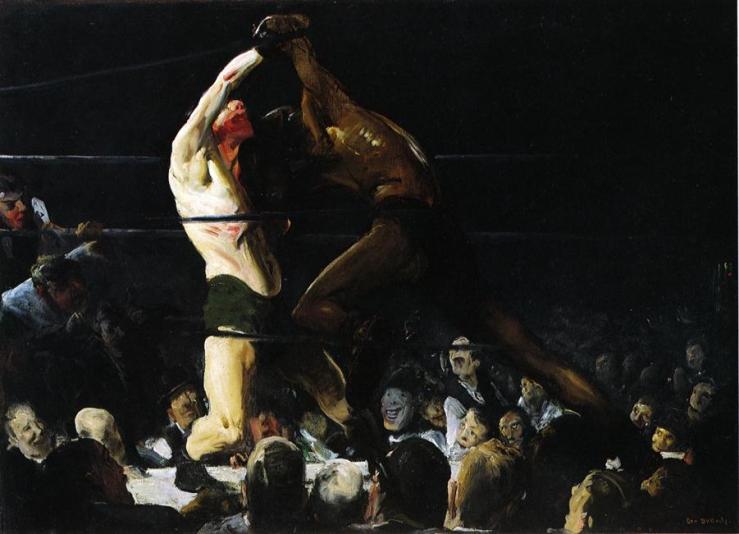
Part of why painters get pissed off is rhetoric such as that Duchamp’s urinal was:
“a blindingly brilliant logical move, check-mating all conventional ideas about art”.
This presumes, like McCarthy’s “locked in the rectangle”, that all painters harbor “conventional ideas about art”. The critic who wrote this for The Telegraph, Martin Gayford, also declared that Duchamp:
“has been compared to Leonardo da Vinci, as a profound philosopher-artist”.
Recently someone wrote in a comment on one of my other articles that Duchamp “changed everything”. This is a very one-sided view of art that presumes painting is automatically inferior to conceptual art. [See more about Duchamp in the Big Bang of Conceptual Art: Why People Hate Conceptual Art Part #4].

Let me illustrate this with another Paul McCarthy anecdote. He told us students about a certain critic who was always shooting down art. I don’t remember which critic. Finally, Paul realized that the critic in question “doesn’t like art”. It didn’t occur to me for decades that it may have been McCarthy who didn’t like art – visual art. The only thing he said about painters was that Edward Hopper represented a backwards Americana, and Pollock didn’t need to do more than ten paintings (precisely the kind of grave misunderstanding of Pollock that I’ve written about). The people who shit on painting are, not surprisingly, not the same people who love painting. McCarthy, like Emin and Hirst, eventually went on to make their own paintings, which I’ll address in the next article.
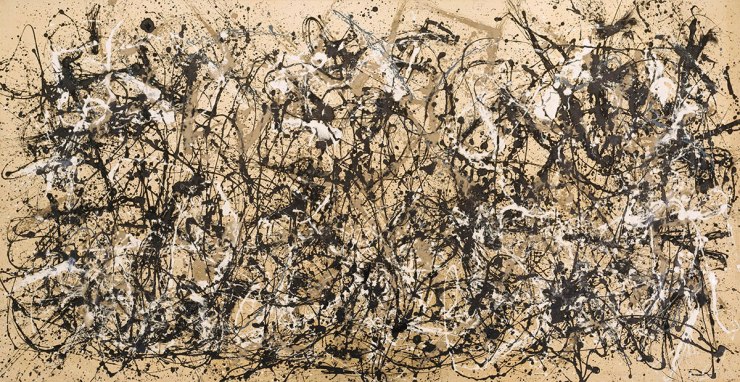
The simple solution to the problem of two branches of art judging each other by their own standards is to stop lumping them together. More often than not conceptual art has far more in common with other traditional art forms than painting. I’ve been saying this master-of-the-obvious trope for years, but I haven’t encountered anyone else saying it. We don’t compare “video” to film, but rather to painting. We don’t compare “performance art” to theater, but painting has another foe. We don’t compare “installation” to other kinds of exhibitions, but rather to painting. We don’t compare “sound sculpture” to music, but to deaf painting. We don’t even compare “text art” to literature, but rather to inarticulate painting. We don’t compare political protest art with agitprop, but rather with politically irrelevant painting. In each case, painting automatically loses, because it can’t do what those other forms can, and they are thus seen as going beyond the boundaries of painting. This is as stupid, if you stop and think about it, as deeming music inferior to painting because it’s blind.
Probably everyone is familiar with Marina Abramović‘s “The Artist Is Present” performance, so that will be my next example.

In 2010, the performance artist mega-celebrity arranged a now infamous performance in which she sat in a chair in a museum for 7 hours a day, for three weeks, and anyone could sit opposite her and look into her eyes (never mind for the moment that this is highly derivative of a Chris Burden performance of 30 years earlier). Here we have someone performing for an audience, more or less on a stage. The piece takes place in time. It’s live. But do we compare it to a play? If we compare it to traditional visual art it’s a “radical” departure. Why, instead of standing up in front of a painting on a wall, we can sit in front of the actual artist! But if this exact performance were done in the context of theater, there wouldn’t be the sense of the artist going above and beyond the conventional boundaries of the medium of art: we’d see an actor doing much less than the medium of theater usually offers.
Conceptual art has no more in common with painting (or more broadly speaking, visual language art) than it does with music, literature, architecture, interior design, landscaping, agitprop, film, theater, or golf. It deserves its own category, and subcategories. The problem of the antipathy between painting and conceptual art then vanishes. But as long as conceptual art has the upper hand, they don’t want to let go of lording over visual art.
Here’s another anecdote. One of the first times I saw installation art in person was at the Barnsdall Art Park in Los Angeles. I was submitting one of my paintings to an open exhibition. At the time, on exhibit were some non-traditional art works. On one wall someone had dissected and splayed tennis balls in every conceivable configuration. I was amused. Someone else had an interactive sculptural piece which would make sounds as you approached it or stepped on parts of it which were on the ground. I interacted with it for a while, tried to see what kinds of sounds and music I could get going. These kinds of art pieces struck me as fun, and exciting.
I really had no problem with them. I had my own ideas. One was to get all sorts of wheels, such as from grocery carts, wheelbarrows, lawn mowers, skateboards, and mount them all in rows on a wall so you could spin one or more at the same time. They could be arranged by size or material or randomly or by some aesthetic consideration. Bigger wheels would make more noise. Multiple people could spin them at the same time, and for the larger wheels you could use your feet to spin them. A more ambitious idea included suspended gas motors of all sorts, hung from the ceiling, all started up and running at the same time in a gallery. If you start thinking along these lines, conceptual art isn’t really that alien.
My problem with conceptual art started as an undergrad, because conceptual art was privileged above painting, and I was not able to pursue the kind of art that I was truly interested in. Even in painting classes I wasn’t allowed to do what I wanted. In my first term at the school, my painting teacher awarded me a B-, and assured me I’d “never make it to grad school” doing the kind of art I was doing. Here’s one of the paintings I made in her class.

If you’ve got an eye for painting, this really is too good to get a B- in a beginning painting class. Quite naturally, my classmates all agreed with the teacher’s assessment of my work, or kept their mouths shut. From her perspective at the time – she made abstract paintings – this work was rhetorically invalid and antiquated. That’s 26 years ago. And after I graduated this same painting was included in a group show at the Orlando Gallery on Ventura Blvd. in CA. Good enough for a gallery, but not for a beginning painting class. My strategy in art school became to play by their rules, beat them at their own game, and learn from them. When I look back I think I’d rather have just stuck to my guns, but, I really didn’t have a choice because you can’t make paintings like the above in a mandatory “New Genre” class.
I suspect many conceptual artists wouldn’t like having their own category which wouldn’t be any more connected to painting than to dance or literature, because than they’d lose the automatic one-upmanship they have over anyone who attempts to make visually captivating images. What if, say, Koons or Hirst weren’t seen as “radical” at all, but merely conventional practitioners of a certain type of art which has been around for about a century?

Imagine a gunfighter walks into a Kung fu school and challenges anyone to a fight: their fists versus his bullets.. Nobody will accept the challenge, and he declares himself the fighting master. According to his criteria, he has “checkmated all conventional notions” of fighting arts, but from the perspective of the Kung fu masters, he’s not even capable of a real fight. As long as the gunfighter’s paradigm is paramount, he has a vested interest in martial arts and gun-fighting being lumped together under “fighting arts”, in which case he is the easy victor. But if “gun-fighting” is a separate category, he may not even be exceptional at all against other gun-slinging, quick-draw artists, or anyone in the military. This is the drawback for conceptual art of separating it from “visual art” – it loses it’s easy supremacy it never deserved in the first place. Conceptual art frequently is compared to painting on all the terms in which painting can’t compete, and none of the ones in which it can.
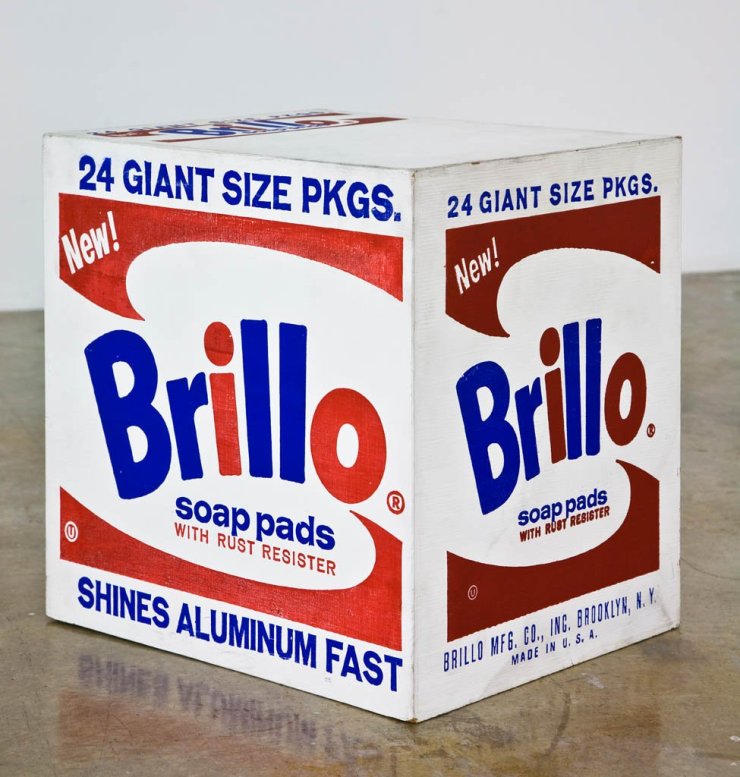
Warhol’s Brillo Boxes, which Koon’s balloon dogs don’t go much beyond at all – instead of appropriating commercial objects, Koons appropriated kitsch – were made before I was born. And yet we still use the word “radical” when talking about something that hasn’t been new for half a century. Much of conceptual art is quite conventional, and has been taught in mainstream art institutions for decades. There’s nothing radical about appropriation. It’s art 101. I did it myself 25 years ago. But we see Richard Prince’s breezy appropriation of other people’s Instagram selfies and other posts presented as some grand innovation in art, and selling for tens of thousands a pop. Again, once conceptual art loses it’s timeless “radical” badge, and just becomes one kind of art-making among others, practices which have indefinitely been associated with radical innovation quickly become ad nauseam regurgitation of stale, decade’s old, academic ideas and classroom assignments. In that case, you’ve got to do something really good, and don’t just get points for not doing painting. In other words, the work can be good, assuming it is, without all the rhetoric that says it is important.
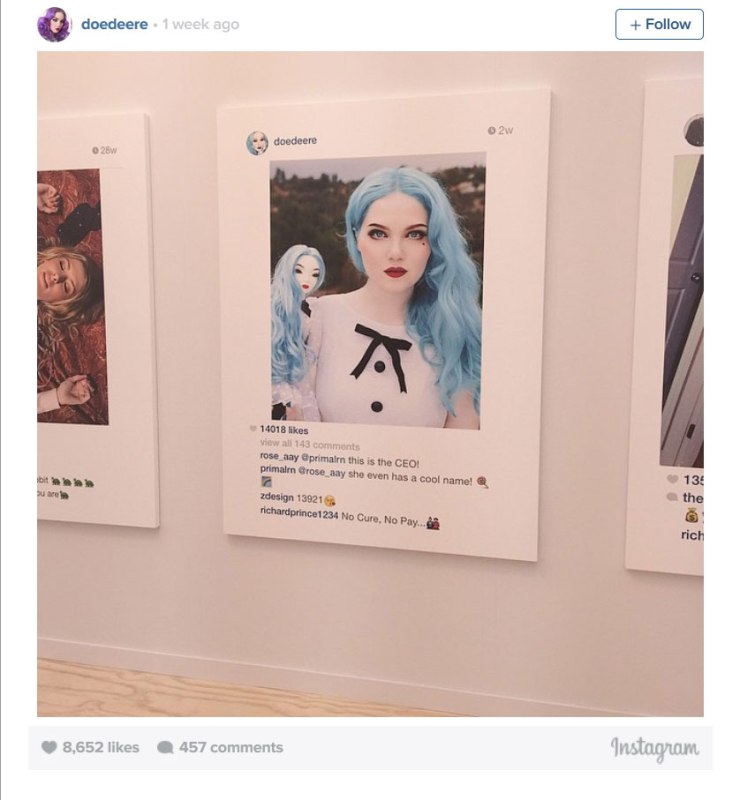
I think conceptual artists know that in some senses it’s easier to do conceptual art than more traditional visual art. For one you eliminate a lot of the historical competition: virtually all of it. You don’t have to go up against anything more than 100 years old. You don’t have to skip over anything that’s already been done well before, leaving few options, and some say none.
If my art is using tape, such as exhibiting objects like bicycles which I’ve completely and meticulously covered in clear tape – perhaps in thin layers or else in such a way that thick webbing is formed between the handlebars – I don’t have so much competition. I can experiment with different types of tape, colors, sizes, combinations and so on. I can tape more than one object together so it’s clever or difficult to determine what they were independently. I can affix them to walls. With a little imagination there’s plenty of stuff for the tape artist to do, if this niche hasn’t already been branded and monopolized. You can tape over objects, then cut the tape, carefully remove the object, and re-tape it. Come to think of it, if I took up being the tape artist, right now – I just pulled the idea out of my ass a minute ago – I’d get more attention and respect than I do for what I’ve been working on for years (though the same would be true if I made unicorn paintings or sock puppets). So there’s a way in which one can easily be an avant-gardist just by adopting somewhat conceptual techniques, without changing anything about how progressive or conservative you are, how open-minded or narrow-minded, or what your relationship is to history. Of course you have to work on your spiel. As the tape artist I’d milk metaphors about transparency, obfuscation, grasping to recognize the underlying infrastructure of an object, and so on. One could easily tie it into politics by taping figures, such as mannequins, with different colored tape. You could have different figures wrapped in different colored tape but all wrapped together in clear tape. The possibilities are endless. But to do something new in traditional image-making requires you go beyond what’s already been done, not just do something else.
Let’s look at how a 1974 video by Paul McCarthy is positioned, in terms of art history, in Wikipedia:
In his early works, McCarthy sought to break the limitations of painting by using the body as a paintbrush or even canvas; later, he incorporated bodily fluids or food as substitutes into his works. In a 1974 video, Painting, Wall Whip, he painted with his head and face, “smearing his body with paint and then with ketchup, mayonnaise or raw meat and, in one case, feces.”
Here is that comfortable idea where you can easily transcend the limitations of painting, and painters, by painting with your head, or shit. Painting is reduced to the physical act of delicately applying pigment to a canvas. This is as ridiculous as reducing writing a novel to typing; reducing designing a building to drawing lines with a ruler; or reducing composing a symphony to making squiggly shapes on paper. The limitation of visual art is not how you apply the paint, but what imagery you produce with it. Eliminating imagery, composition, subject matter, and all colors except black (as in the video above) hardly expands the boundaries of painting: it reduces it to an infantile act.
The limitations of painting are the limitations of the imagination. Notice how those who boldly go beyond the limits of painting have very little in the way of offering how they pushed the limits of painting before going beyond them. Duchamp once said:
“I didn’t have any ideas to express. I didn’t, never, considered myself like a professional painter. You know, a professional painter is a man who paints every morning. And he paints quickly or slowly, but he paints all the time. And painting always bored me. Imagine. So, I had a hard time finishing a painting.”
The man who is credited with “checkmating all conventional ideas about art” didn’t have a single unconventional idea about painting to explore. This was HIS limitation, not that of painting. Duchamp submitted his urinal as art in 1917, but Salvador Dali painted “Persistence of Memory” in 1931. Dali successfully pushed the boundaries of painting in a way that nobody had before, 14 years after Duchamp declared painting washed up.

Calm down folks, I know, I know, Dali is a whopping cliché. He was my favorite artist when I was 18, but I’d lost interest by the time I was 19. Nevertheless, “Persistence of Memory” is an unusual painting presenting a novel visual image. If, like me, you have a tendency to turn your nose up at Dali, and find his posturing insufferable, have a look at this short video to help see “Persistence of Memory” afresh.
Some people will reject my solution to the painting vs. conceptual art problem. They will say, “Why separate the arts?” “This is going backwards”. Well, no. It’s removing an artificial packaging of conceptual art (including new genre) with visual art, and apart from film, acting, literature, publicity stunts, cosmetic surgery, music, landscaping, advertising, and so on. Video and performance art that is seen as revolutionary as compared to painting, because it’s not “locked in the rectangle”, can easily become self-indulgent playing, or nothing especially unique, when compared to the acting and props in a film, such as Alejandro Jodorowsky‘s “Holy Mountain” of 1973.
Instead of comparing “Painting, Wall Whip” to Edward Hopper, and from the perspective that Hopper is only capable of limp-wristed paint daubing, let’s compare it to Jodorowsky’s film of a year earlier. Holy Mountain is filled from beginning to end with similar stunts, and can easily be seen as a feature length “performance” + “video”. [Just as an aside, is Evil Knievel a performance artist? Think I’ll need to write an article about that.]
Here’s an actor whipping sculptures of Christ to pieces.
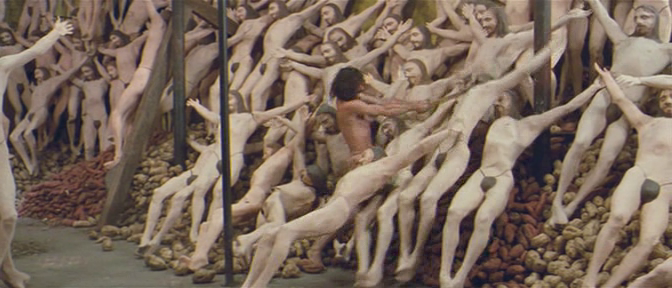
Here’s a painting being pelted with paint balls by some children.
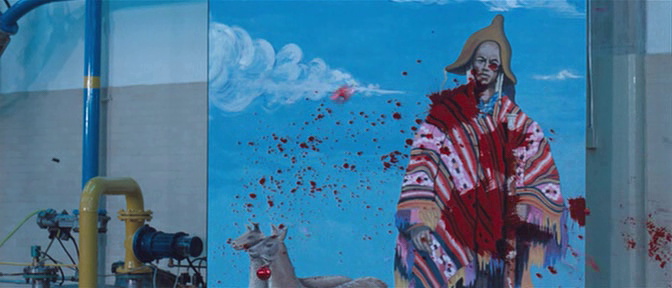
And here are people making paintings with their butts, assembly line fashion.
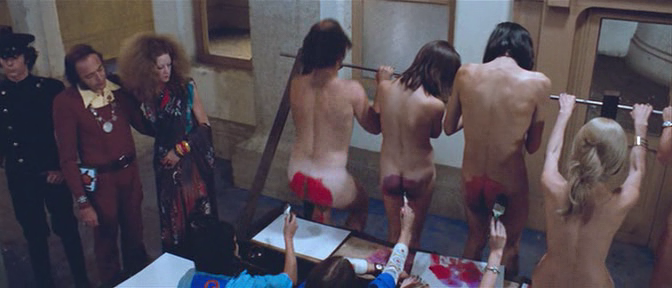
Oh, but McCarthy used shit! He is more “radical”. In the sequence with the alchemist below, the subject’s shit is turned to gold.

and

Dang! That shit’s on fire!
If one had been lucky enough to see Jodorowsky’s film in ’73, and then saw McCarthy’s “Wall Whip” of ’74, one might not even think to compare it to the tradition of painting, but might instead see it as someone’s attempt to make a scene for a Holy-Mountain-derived home movie. Further, it becomes impossible to see McCarthy’s act of whipping a wall with paint as “revolutionary” when that sort of action was well covered, and even parodied, in a movie of the prior year.
When we look at McCarthy’s mature work, his use of props, sets, prosthetics, and simulations of blood, feces, and bodily fluids are nothing special or shocking if you’ve already seen “Holy Mountain”. Instead, they become familiar, like small-scale, less ambitious, less resolved, deleted scenes. Compare McCarthy’s performance, “Painter”, in which he portrays an Abstract Expressionist using a brush as a penis to penetrate a canvas, while mumbling de Kooning, to the sequence in the film where an artist uses a giant phallus to penetrate a machine.
Here’s McCarthy breaking new ground in 1995:
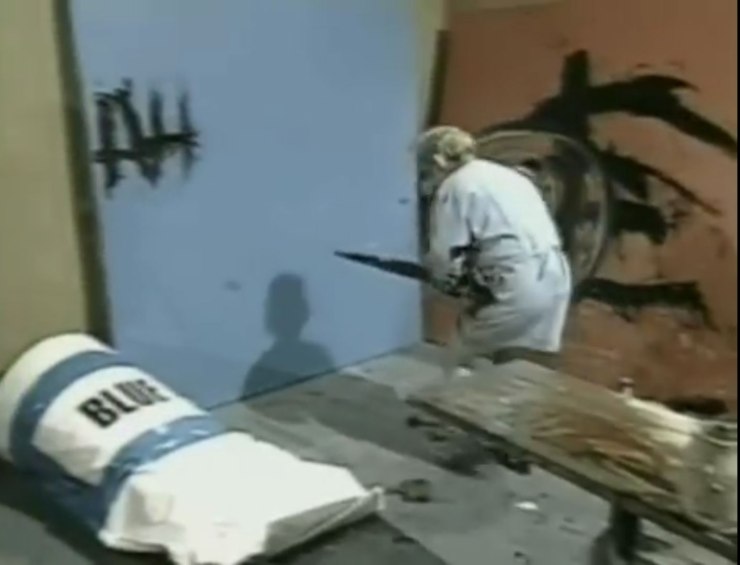
And here’s Jodorowsky doing something similar, but more elaborate, over 20 years earlier.
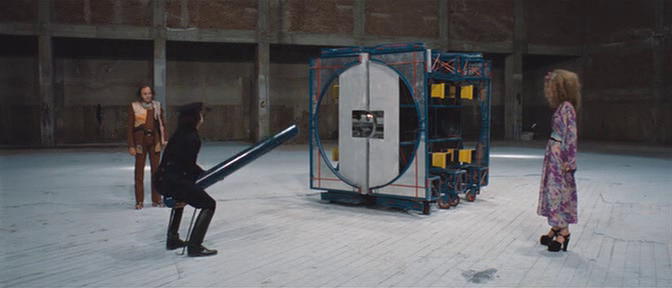

Are these prosthetics from a McCarthy performance in the new millennium? Nope, you guessed it, just another still from Holy Mountain.
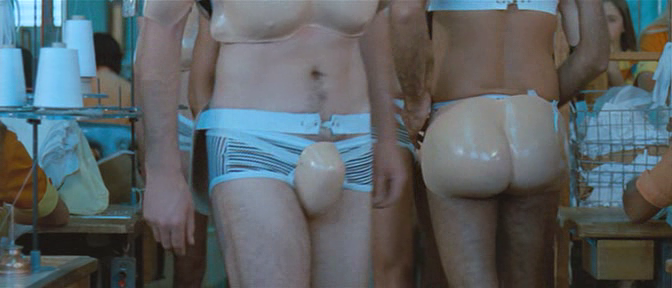
Does it make more sense to compare McCarthy’s “Painter” to deKooning, as he would want us to, or to the art scenes in Holy Mountain?
I just did a Google search for “Paul McCarthy” and “Jodorowsky” which turned up just a few hits in English, and not a complete sentence or paragraph I can quote. The comparison is not customarily made. However, a search of “Paul McCarthy” and “de Kooning” gets over 28,000 results, the first ten pages of which seem legitimate. Soonish, the only English hit you are going to be able to find comparing McCarthy to Jodorowsky will to lead you here (unless enterprising art critics nick my art criticism). Why am I the only person saying this shit?
Part of the reason is it’s not welcome news in the art world, as it threatens the importance we place of revolutionary art acts within a given narrative of the progression of art history. People’s livelihoods depend on this belief NOT being countered. Additionally, critics benefit from an environment in which conceptual art is agreed upon as superseding traditional visual art. The tools of the critic are ideas, and the core of conceptual art are ideas. Art becomes a game of ideas negotiated by critics, which gives them a purpose and power. Critics and theory are needed just to assess the art. Contemporary art is in part a belief system, and an institutionalized one at that, which panders to the proverbial 1%, who are the only ones who can buy a Koons’ Balloon Dog. The buyers reciprocally have an influence on what is sold, and thus what is taken seriously. It’s like a religion, and I’m a non-believer.
McCarthy’s probable unintentional strategy at one time was to take something from one genre, where it is second rate, and put it in another, where it becomes automatically revolutionary. Of course that is the radical technique of appropriation, or re-contextualization, by which you take something like a neon sign, which wouldn’t hold your attention for more than a few seconds, and put it in an art museum where it becomes timelessly worthy of admiration. For example, take McCarthy’s giant inflatables. He made (or rather, ordered from a business that makes inflatables) a giant balloon dog, a giant crap, and a giant butt plug. As works of art in a gallery/museum context they are ENORMOUS, and their enormity alone signals their importance. But if you compare them to other giant inflatables, then there’s just that little twist of them being about art history, in which case you may chuckle, but not out loud.
McCarthy’s giant butt plug of 2014 pissed off the local Parisians when it was, er, erected, at the Place Vendome in Paris.

Y’know, I have the prescription goggles. I can put them on and see this as a challenging work of conceptual art. But I can also take off the goggles, and recognize it as a giant inflatable, only the size of which elevates its plebeian production momentarily above the clinically mundane. Taken out of the art context the butt plug is on par with the turkey below.

This sort of water-into-wine transmogrification only works if you are a believer in the narrative at hand. You have to believe that art history is moving forward and taking humanity along with it, and you have to believe that these attempts to change the course of art history with the wave of a hand are successful and meaningful. It takes a leap of the imagination some can’t make. And it’s also a leap of the imagination that can be made, and then disavowed as having been a bit of a fantasy. Those cheese graters on a pedestal were only shocking or interesting within a given artificial context one had to already believe in, in which case they become a clever strategic move.
But there is that shadow of doubt that Paul McCarthy slinging a blanket drenched in paint against a wall is NOT really a philosopher breaking through conventional thought and opening up new vistas of the imagination. It could be a kind of sad spectacle of a guy with serious delusions of grandeur. When you think you are changing the course of history by doing an art stunt, there really is a good chance you are fooling yourself.
If one were to challenge McCarthy on his “Tree” or giant crap, or other inflatables, and argue that all he did was call up a company that makes that shit and order up an art piece, he’d counter that he’d thought of it, and that was the art. If you than said that anyone could think of it, he’d argue, “but you didn’t think of it”. I’m not just pulling this out of my ass, I was a good student, and I remember the paradigms I was taught in my art classes. That was his position in class. But I have a counter. I can think of giant inflatables he hasn’t made, and I can document that thought in a way you will presently see.
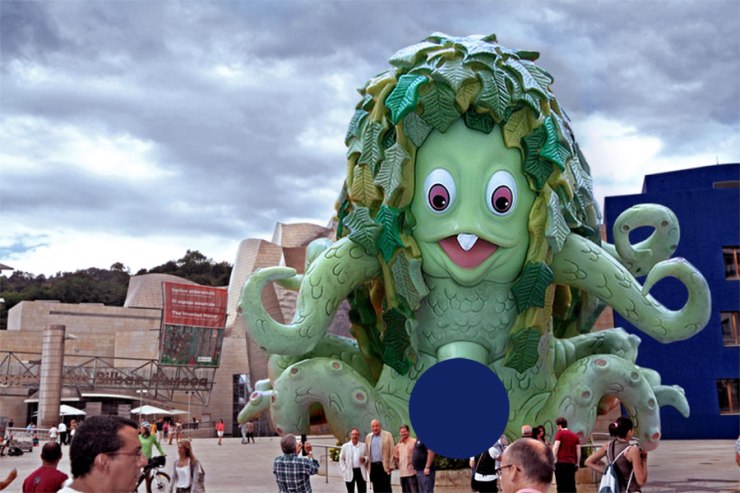
Above is my own off-the-cuff idea for a giant inflatable: Sigmund the Sea Monster Dong. There it resides outside the Bilbao Guggenheim. You can see the uncensored version in the article about this piece. I had to remove the uncensored version from other places because, for whatever reason, it became the #1 image that would crop up if you did a Google search of my name. As I was looking for work, it just gave the wrong impression, and I rather suspect I may have lost one teaching job I was eminently qualified for because of it, as the employer seemed unusually interested in my art, which really has no bearing on the position I was applying for. Probably thought there was something wrong with me, not realizing it was parody. I’m probably just being a bit paranoid, but when there’s no obvious explanation, the mind entertains fantastical scenarios.
And here’s my giant cock-blocking Fly, which bars the route to McCarthy’s giant shit-pile.

You guys know I made those in Photoshop, right? Wait a second. Photoshopped conceptual inflatables. I think I have a monopoly on this peculiar art form, though really it’s more of an illustration for another article. You can click on either of the above two images to go to articles about them, which I guarantee are amusing, because I wrote them to be so. I created magazine spreads with features about these nonexistent monuments of revolutionary conceptual inflatables. You know what was really cool about it to me, though, and that’s just that it does look like real art – the presentation accrues that sort of authority to it. I do think if that giant Sigmund the Sea Monster Dong could be made, it would be right up there with Koons’ and McCarthy’s and Hirst’s shit.
Thinking of making a giant inflatable isn’t really the hard part, and is about as easy as it might seem. The difficult element is having the money, connections, and brand name to have it made AND get recognition for it.
The overlap between mundane examples of what is traditionally non-visual art and radical breakthroughs in visual art is dumbfounding. Warhol made a career of elevating commercial illustration to high art by, well, positioning it in the museum/gallery context. Koons frequently merely commands his small army of artisans and specially trained experts to make gargantuan versions of ordinary toys. Performance artists make cringe-worthy theater into revolutionary visual art. [By the way, I’m still reflecting on whether or not Evil Knieval was a performance artist.]
Many may disagree. Marina Abramovic, for one, sees a critical difference between her art and theater, and it’s worth examining whether it’s a valid distinction or not:
“To be a performance artist, you have to hate theatre. Theatre is fake… The knife is not real, the blood is not real, and the emotions are not real. Performance is just the opposite: the knife is real, the blood is real, and the emotions are real.”
This is already highly problematic because you have to “hate” another art form, and this is that same mentality of conceptual artists deriding painting. But aside from that bizarre and extremely narrow-minded prejudice, other performance artist’s do not use real blood. Here’s McCarthy distinguishing himself from the Viennese Actionists:
Vienna is not Los Angeles. My work came out of kids’ television in Los Angeles. I didn’t go through Catholicism and World War II as a teenager, I didn’t live in a European environment. People make references to Viennese art without really questioning the fact that there is a big difference between ketchup and blood. I never thought of my work as shamanistic. My work is more about being a clown than a shaman.
But, sure, I know what Marina is talking about. Her art strives to be about real actions, real transformation, and real being. Perhaps the primary constant in her performances was the endurance test. But is this really foreign to theater or film?
In preparation for shooting “The Holy Mountain” Jodorowsky and his wife went without sleep for a week under the supervision of a Japanese Zen master. The cast underwent three months of spiritual training and lived for a month communally in Jodorowsky’s home before production. Actors also imbibed psychedelic mushrooms before certain scenes. These are serious attempts at actual personal transformation, and include lengthy endurance tests. So, no, Abramovic’s reason for hating theater is a false antithesis, and probably every art form can include components of endurance and transformation. Think of Michelangelo painting the ceiling of the Sistine Chapel. He had to stand on scaffolding and paint while reaching high above his head.

I’m guessing painting above your head all day is even harder than sitting on your ass all day. But in addition to the physical/mental feat of endurance, Michelangelo painted the ceiling of the Sistine Chapel (the endurance part was merely an irrelevant obstacle to overcome and not bitch about). In Abramovic’s case, we don’t get the ceiling, we just get the artist taking a prolonged break, starin’ at us.
While watching The Holy Mountain a scene at the beginning struck me as similar to works by the Chapman brothers. Here are a couple stills from the movie.
and
And here are a couple pieces by the Chapman brothers.
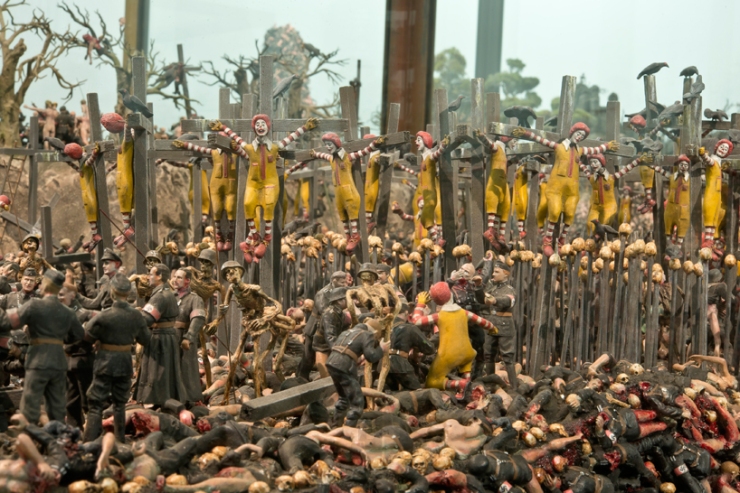
and

Fascists and crucifixions!
The sculptures in the art sequence were not entirely unlike body-sculpture Charles Ray (another of my teachers) created in the eighties. First the stills:
and
And here are a couple sculpture/performances by Charles Ray:
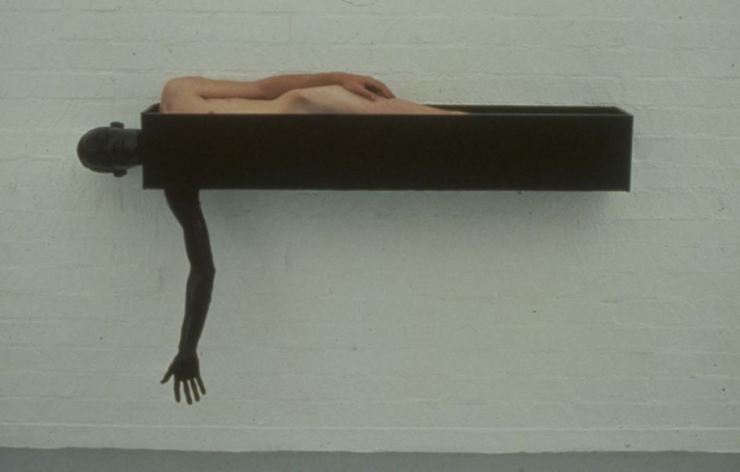
and

Charlie Ray’s pieces are much more elegant and sculptural, but there’s certainly more overlap between his work and certain scenes in the film than there is between it and painting.
Performance art, installation, and sculpture can, intentionally or not, imitate film without being compared to film, but instead with painting. There’s a disinclination to compare performance art even to other performance art.
Let’s go back to Marina Abramovic’s infamous, The Artist is Present (2010), which had so many celebritie’s eyes welling up with tears when they sat opposite her. As I mentioned before, Marina sat in a chair in the gallery for 7 hours a day for three weeks, and anyone could sit opposite her and gaze, self-mesmerizingly into her eyes. The performance accompanied a retrospective of her art at MOMA.

First let’s get some accolades from critics. Y’know, the type stuff I’ve been talking about where art matters because it changes history. Here’s Charlie Finch for Artnet talking about the retrospective and the performance in particular.
It is as distinctive and as potentially influential as the debut of Stravinsky’s Rite of Spring or the opening night of Waiting for Godot.
Is it?
Here’s Richard Dorment for The Guardian:
Marina Abramovic staged a breakthrough work that not only transformed the medium of performance art, but brought her a level of international attention usually reserved for movie stars.
My first reaction upon discovering Abromovic’s The Artist is Present wasn’t that it was new, transforming performance art, or potentially a breakthrough on par with Stravinski’s most famous work. I thought it was a watered down version of a performance Chris Burden did 35 years earlier. In his “White Light/White Heat” of 1975, Burden remained in a gallery for 22 days (without leaving to go home like it was a regular daytime job), subsisting only on celery juice, and hidden from view lying in an elevated triangular platform in a corner of the building.

Burden’s piece was also about presence, and he was present even when gallery goers were not, but he did not receive any direct attention. The artist may have been present, but the art star, and celebrity, was not. While Abramovic’s performance made her all-important, Burden’s rendered him barely distinguishable from non-existence. The key element, however, is the artist remaining in a fixed position in a gallery for roughly 3 weeks. If one is already familiar with Burden’s performance, Abromovic’s seems self-aggrandizing, pretentious, and even arrogant – people queued up in the thousands to have an audience with someone who just sat there gazing back at them, and nothing more. If she were an unknown, or unattractive artist, she could do the same performance for 6 months and nobody would give a shit. People aren’t going to queue up to gaze in the eyes of a nobody. Knowing that people WILL line up to prostrate themselves before you is a kind of narcissistic confidence I don’t particularly find admirable.
But let’s see if anyone besides me compares “The Artist is Present” to “White Light / White Heat”. There are a few articles where both pieces are mentioned, but the only link to one that compares them that I can find is to another of my own blog entries. So, with all the writing about art out there, and one of the most infamous pieces of the new millennium, nobody bothered to compare it to an obvious earlier performance art piece.
Now let’s see if anyone compares “The Artist is Present” to painting. Enter Jerry Salz, perhaps my least favorite critic [incidentally, he blocked me on Instagram for commenting on his “Go Hillary” post, “Go business as usual”], writing for artnet:
People have engaged with this work in ways that are as intense and profound as their interactions with paintings and sculpture.
This seems a rather obvious point to make, especially as it’s more likely to be engaging to sit across from someone and stare into their eyes than it is to gaze at one of Robert Ryman’s all white paintings.

It’s rare art that’s going to be more engaging than interaction with another person. That is a strength of art – that you can be captivated without another person being there. His argument is a bit like comparing a lap dance to one of Modigliani’s nudes, and mock-generously concluding that the lap dance is as engaging, erotic, and sensuous as the painting. That wouldn’t mean that the lap dance was better art than the Modigliani. The trick is to engage through a medium, to somehow invest feeling and presence into something which would otherwise be inert (assuming the art in question doesn’t want to be inert for conceptual reasons). You get the picture. It’s uncanny if a Rembrandt self-portrait gives you a sense of a real human being, but it’s nothing worth noticing if the person at the register when you buy groceries seems so convincingly human.
The real, underlying reason to make such a rhetorical point, I’d imagine, is to emphasize how “radical” Abramovic’s performance is relative to painting and sculpture, once again playing the conceptual-art-trumps-visual-art card.
It would be far more appropriate to compare Abramovac’s performance to Amma, the hugging guru‘s routine of hugging thousands of followers? It’s supposedly an “intense and profound” experience.

But if we compare “The Artist is Present” to Burden’s “White Light/White Heat” or to Amma giving hugs, Abromovac’s performance loses it’s “radical” edge, and becomes possibly derivative, indistinguishable from non-art spiritual rituals, or both. It appears much more like someone doing a fairly conventional performance art piece that could equally have been done 30 years prior, and which also may borrow heavily, and problematically, from guru rituals. And as I argued before, the performance could only have been done by a respected celebrity. There’s an element, to me, of narcissism – basking in the attention and fame of a performance where you are adulated as an immortal – that I don’t find “radical” at all, but rather conventional and naive. But these doubts can be held off by comparing Abramovic not to Burden or Amma, but to an anonymous painting or sculpture.
I don’t know that there’s much anyone can do to persuade global-warming-denying, alt-right conservatives that conceptual art isn’t shit, or more specifically “dog shit”, but for others I think it’s possible to shed their resentment of conceptual art when the rhetoric surrounding conceptual art drops its own condescension, and its false presumed automatic elevated status above anything anyone paints. Then, instead of a conceptual piece either being “dog shit” or a “radical breakthrough” it can be assessed on appropriate terms in which case most works will be rather conventional attempts within a given, well-established discipline, with a few standouts.
When conceptual work is not automatically undervalued (because it fails by the standards of traditional visual art), or overvalued (because it’s presumed to be more evolved than visual art), we can appreciate it more for what it is, without resentment or false adulation. Let’s look at a piece by Chris Burden.
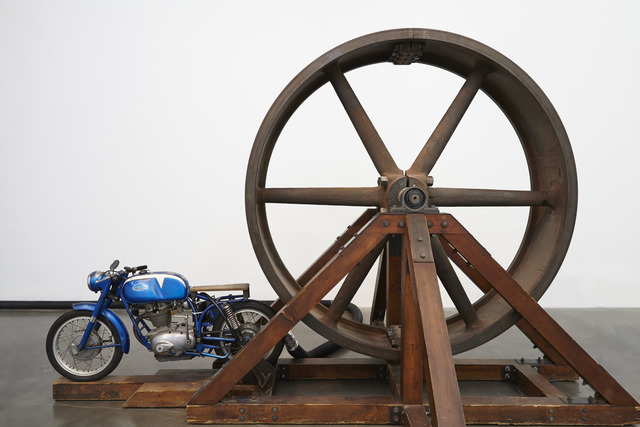
Paul Watson or Joe Rogan might march through the gallery and just see a motorcycle hitched to a wheel and call it “dog shit”. Unless, of course, it were running. The motorcycle is used to spin the wheel, after which it will continue to spin at a velocity where if it were released from its supports, it would immediately bust through the walls of the gallery into the street and cause pandemonium and probable injuries. It’s both a stationary sculpture, and a spinning object with incredible, palpable force. Here’s a video clip of a woman starting it up and then letting it spin:
This video has 109 likes, and 39 dislikes. 37% of people who bothered to vote on the video disliked it. Chris Burden is one of my favorite conceptual artists, and, just an aside, I originally signed up to take a class HE was teaching at UCLA, but ended up getting Paul McCarthy instead. This may have been a good thing, because I actually admired Burden, and, well, I might have done work which was more along the lines of what he did, which could have been a bit dangerous (if you know his work). The fact that people don’t like this work makes me think they are blinded by their own rhetoric, which is quite probably a response to the rhetoric of conceptual art.
A good way to approach this piece is to take it out of the god-forsaken crucible of art history, and imagine it’s something your neighbor set up in his or her garage. Unless you have no sense of fun, cool, curiosity, or experimentation, you’d probably want to see such a contraption, and also would be a bit frightened by it. Outside of the rubric of “Art” it’s a wicked cool construction.
Some people who don’t like conceptual art are really stubborn about it, and will poo-poo this work, and even stuff by someone like Andy Goldsworthy, who is almost impossible to not like without being deliberately closed-minded . The reason is the competition they feel between this kind of art and visual art: a competition which shouldn’t exist. Comparing “Big Wheel” to a painting by Edward Hopper is as ridiculous as comparing it to a folk/rock song by Bob Dylan. It would make far more sense to compare it to Serra’s “Band”, since they both use metal, gravity, and implied danger in their work. “Big Wheel” is a good piece of art which doesn’t need to be justified by obtuse art rhetoric.
The comparison of conceptual art to visual art insists that one or the other is irrelevant. One genre is not superior to another. I think some of the very best art of the last hundred years are Rock songs, including songs that were primarily just a person sitting there playing an acoustic guitar and singing (John Lennon’s “Working Class Hero”, Dylan’s “Masters of War”, or Kimya Dawson’s “12/16”). The medium is not radical, but what one does with it is either imaginative and captivating or not. This is a realization I had in art school when a fellow student told me his favorite artist was Kazimir Malevich, because he was “the father of abstraction”. I’d seen Malevich’s infamous Suprematist Square, which is a painted black square on a white canvas, and though I appreciated it’s ostensible place in art history, knew it didn’t mean shit to me compared to, say, Led Zeppelin’s “Whole Lotta’ Love”, if not for the guitar solo alone.
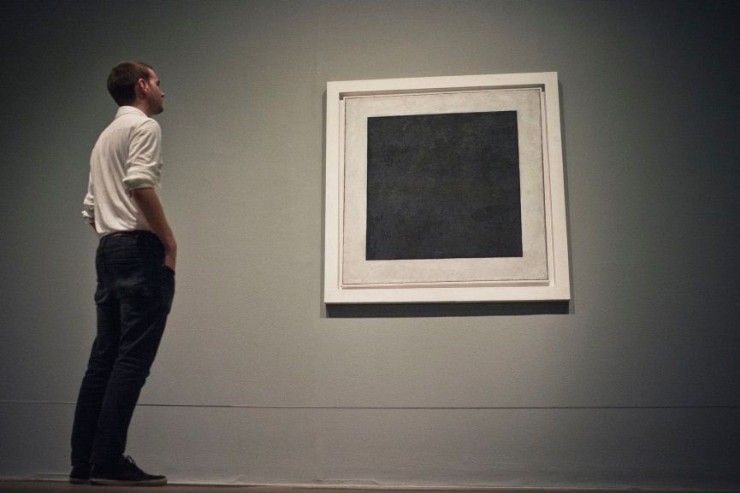
Malevich’s piece was cerebral as all shit, and I just got so much more out of Zeppelin (oddly, Jeff Koons is also a Zeppelin fan, though his work has absolutely nothing in common with the rock group). My classmate liked Malevich because he thought he was important, but I realized I didn’t give a shit what was considered important or not. Art appreciation was between me and the art, not between me and a prop signaling a treatise on what art acts were important and why according to a certain rubric. “Important” is extremely relative, and changes over time, but some art has a kind of self-authority, inevitability, quintessential quality, or timelessness that defies positioning as significant or not. Instead of valuing what art I thought was important, or rather what some authorities thought was important, I strictly valued art in relation to how much I liked it, pure and simple.
What I’m getting at is there’s a prejudice about mediums which is utter bullshit. Whether you sit down with a guitar and sing a song, make a (digital) painting, write a story, or make an installation is irrelevant. It’s all about what you do with the medium. If you don’t like painting, that’s fine, we don’t all have time to investigate every medium, but If you argue that it’s an antiquated practice, you are brimming over with self-righteous bullshit. And the same goes for those who deride conceptual art as inherently bankrupt.
I think we should treat art more like cuisine and less like religion. Instead of seeing artworks as battles in a war of rhetoric in which the loser is rendered worthless, we should enjoy all styles as a rich variety of entrees at a buffet. To do that we need to dump the rhetoric and engage art directly. Some art that is propped up with convoluted rhetorical justifications will fall down many notches, and some that is disqualified on theoretical grounds as being fine art at all will ascend in leaps and bounds.
If you found this article interesting, there’s one that’s much more recent and dismantles the dominant art narrative (with humor): Dismantling the Dominant Art Narrative
~ Ends
Your intelligent comments are welcomed. And there may already be some interesting ones, furthering the discussion. [Edit: right now I have several angry troll comments, and a few intelligent ones.]

You can see more of my art here (has details and links to full posts on each piece), or just preview by clicking in the gallery below.
NOTE: It’s hard for me to not find myself sounding opinionated. It’s hard to not circumscribe in words what should be open. This article reflects my current views and ideas. I may be wrong about some of it, or see it in a skewed way. I would imagine all of that is already true from a much broader perspective (not a narrower, opposing one). I would hope to reach for the broader perspective, and in that sense would hope for the rewarding instance of finding out I was wrong, because it would indicate a new avenue of understanding was available to me, or at least a small branch. You are only wrong until you admit you are wrong, after which you are just more in tune. Being right is an impediment to being in tune. I’d say my article is hyperbolic, which to me it is, a bit, except that the rhetoric I’m talking about, and certainly the videos of Watson and Rogan, are much more hyperbolic. Where I’d want to fault myself for a kiss of the ridiculous, I have to compare it to the gaping maw of the ridiculousness of popular culture, in which Donald Trump could be the next American president. I wouldn’t be able to suspend disbelief if I were reading fiction that predicted such an outcome. Reality is not only stranger than fiction, it’s stupider.
I very well may change my mind, or rather my interpretation of something that’s so much bigger than I am I can only have one toehold on it. There are infinitely more perspectives. Everyone has a perspective that is a separate universe unto themselves.
So, yeah, I hope I”m wrong about some things because they would mean there’s more to discover, which I believe there always is (unlike some artists, who are considered the most radical BECAUSE of their cynicism). I could only look back at a narrow view from a greater view, at which point I’d have reached a greater view.
And if you like my art and art criticism, and would like to see me keep working, please consider making a very small donation. Through Patreon, you can give $1 (or more) per significant new work I produce, and cap it at a maximum of $1 a month. It’s also absolutely painless to cancel with the click of one button. So far I only get $6 a month. That’s so little it’s embarrassing, but still better than nothing or a sharp stick in the eye. Ah, if only I could amass a few hundred dollars per month this way, I could focus entirely on my art. See how it works here.
Or go directly to my account.
Or you can make a small, one time donation to help me keep on making art and blogging (and restore my faith in humanity simultaneously).
If you see any ads below here, I have no control over them and get no money for them.



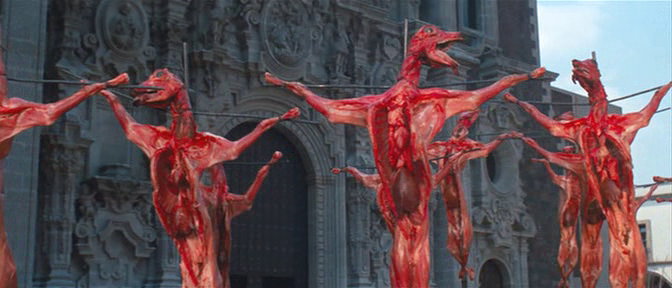

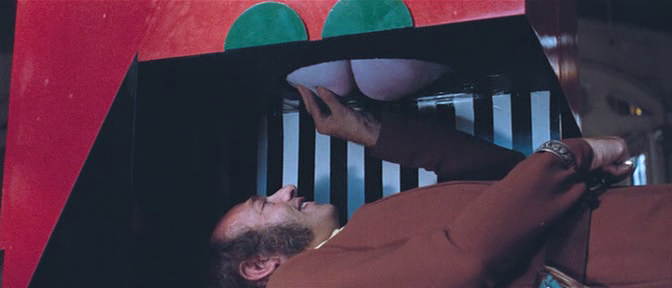































Wow you are giving us a lot of thoughtful information here. Very interesting take!
LikeLiked by 1 person
Thanks for reading and commenting. I’ts great to hear that people are getting something meaningful from this article.
LikeLiked by 1 person
I’m glad you put in the time to share your thoughts and introspective knowledge. Thanks again 😊
LikeLiked by 1 person
don’t understand why people choose hate over ignoring.
LikeLike
It’s hard to ignore hate, and much of contemporary/conceptual art is build on a hatred of painting. See Marcel Duchamp.
LikeLiked by 1 person
i should have said, except for artists. Hate’s a good catylist. I was thinking of the audience
LikeLike
I try to be more generous and forgiving, and encourage all art practices. But, there’s that little thing where Maurizio Cattelan taped a banana to a wall, and it made art world news, and more than most artist’s will make in their entire lives that adds insult to injury. One has to be pretty humble to accept kicks in the teeth and not get upset about it.
LikeLiked by 1 person
wow, please publish as a thames and hudson book, its great
LikeLike
Wow that’s so much information!! I got to know a lot many things. Thanks for writing this post.
LikeLiked by 1 person
Good stuff Eric. Thanks for showing the variety of art that exists. I havn’t picked up a brush since Mr Corona came to town. Pen and graphite, yes. Gimp and Inkscape too. Brush, no. Must be another symptom of Corona (as meme). Don’t trust the future enough to start something on gesso. There is a run on flour and seeds and exercise bikes….is there also a run on tubes of acrylic and oil paint and canvas? Time to visit Cheap Joe.
LikeLiked by 1 person
Excellent essay!
LikeLiked by 1 person
Thanks!
LikeLike
This is a great article!
LikeLiked by 1 person
Thanks! Glad you liked it.
LikeLike
I think there should have been made distinction between visual art as visual art, installations, conceptual displays and conceptual performance. It is kind of silly to put it all under one name and then expect nobody to object.
Many years ago, when I just arrived from Europe to Canada, I was trying to understand Hirst more. It seemed he had painted still life before his very highly priced installations of medicine cabinets, cow and what else there was. His still life paintings were below the average I’d say at that time. My personal point is that it is very difficult to become visible in traditional media, but it is easy to attract attention with nonsense. Over the last 5 decades, we’ve seen so much of it, all kinds of. Therefore, people, who have absolutely no talent, no drive for visual art and who really do not want to spend the huge time it takes to create something outstanding in the field of more traditional visual art, have moved to modern art, to contemporary conceptualism, to weird installations just to maybe catch the nice feeling of becoming famous for their attempts without spending time and putting in efforts.
In regard to conceptual contemporary displays , I must say the emperor is naked as in that tale about weavers, who promised to make outfit for the emperor and people, who are stupid, not fit for their positions or simply not classy enough would not see that outfit. This is happening all the time: there is assigned meaning to completely meaningless, sometimes simply dumb displays and installations which art collectors seem to be good at investing in.
It’s also so that we have made a loop: we went to mastery through many hundreds of years and then decided to return to something more simplified than signs and symbolic drawings on caves in caveman’s era. Which is kind of sad. Plus, the pretense that somebody is so much higher class if they can accept purely shit as top-level art. Makes one wonder, too, whose interests are here on somebody’s mind when they praise concepts which are far from concepts and make people think that this is some kind of extreme achievement.
LikeLiked by 1 person
Yes, I think you are onto something about how artists such as Hirst were never very good painters to begin with. We never see the great paintings they did before they miraculously leaped beyond the boundaries of painting into the conceptual realm. So, it’s not as if the best painters evolved into doing conceptual art. Nevertheless we are to believe that the work of conceptual artists necessarily encompasses the best of painting. We don’t presume that Hirst is a better musician than someone else because of his various props, but we assume he’s a better visual artist than virtually all painters. He is considered a better “artist” than a painter even if he can’t paint very well. This only happens to painters. There’s no other art form where you can be better than people at that medium without actually being able to use the medium.
Contemporary art also allows one to get away with a gimmick, and the gimmick is often synonymous with the art. It is much more difficult, as you say, to compete with every visual artist who has gone before, then it is to do something else altogether. And if you do make visual art proper, gimmicks are no longer the shortcut to art history: they are completely irrelevant. You can’t bullshit your way into the museum anymore, not even a little bit. Well, some may make it that way, but they will be eliminated eventually.
LikeLiked by 1 person
I believe that somebody looking at contemporary two-sticks or one big blot concept after 100 years might wonder; what exactly what that about?
I don’t assume humans are only capable of such sloppy concepts as Hirst presented us with. You have huge insight, and you more than I probably know that there exist valuable concepts, as well. Just like with any form of art, excellence is rare.
Visual art has for many years praised people, who have mental disorders and, therefore, create something off the regular path. I would call this exploitation of person’s condition although, they benefit at the end.
I agree that no other form of artistic expression would allow very weak creations to be raised to the sky.
The sad thing is that contemporary works get promoted a lot, compared with traditional visual art forms. Nobody wants to appear dumb, and whether they can find the hidden meaning in such work or not, they will pretend they totally get that concept and its visual presentation.
You have excellent blog. Discussion always beats simple refusal to admit that the subject exists.
LikeLiked by 1 person
Article was SUPER–DUPER-UBER-Pretentious. I get why you don’t see it, the bias is obvious by the way your writing is structured. You seem to genuinely think these ideas are “challenging norms” and thats what upsets people, but the reality is that they paid money for tickets to an art show and were expecting to see more structured art when they bought tickets.
It’s the exact same reason people get upset at Justin Beiber and Miley Cyrus, you can autotune your song then just press buttons let things happen and make millions, I’m not going to say “iT’S nOt EvEn mUsIc!!!” but it almost certainly takes less talent and is copy pasted like most pop music. It sells and is popular based only off novelty synth sounds… meanwhile thousands of others spend WAY more time practicing an instrument that nobody will appreciate. It’s like when people try to say that Kurt Kobain was a great guitarist, he was a decent guitarist and a great songwriter, but calling him a great guitarist is an insult to anyone who can play over 150bpm and hold a tempo.
Nobody said you can’t vomit paint onto a canvas and sell it, or make random scribbles and pretend like its the universe…. but dont act like these people are doing this for the edginess or even artistic value when they slap on price tags of $100k+ for something that looks like it took them less than a week to actually put together. And yes that value is subjective but if you value abstract and vague concepts more than determination and hard work then we will likely never see eye to eye because those are messed up priorities.
I hope to see you down here in the real world some time bud, I bet it’s cold up there.
LikeLiked by 1 person
I’m not sure who you are addressing, me or someone who made comments.
I agree with your stance on Kurt Cobain and on pop music. I also agree that vague concepts certainly don’t trump hard work and determination.
So, not sure who or what you are disagreeing with. I’m guessing you didn’t really read the article, because if you did, I don’t see how you could come to those conclusions.
Cheers.
LikeLike
it is not the obligation of any new art to be shocking
to express with force the thinking of the new artists
to rock the world of art and create new things and innovate
LikeLiked by 1 person
I think it often has to do with the first impression that “anyone could do it, and someone DID – but that does not make it art.” However, most of us are not taught about what makes art, art. So indeed, it looks at first blush like a heap of nothing. When we consider that art is about making a statement using agreed-upon rules (like rhyme and meter or lack of it rules poetry), it helps to KNOW at least some of the rules…Woe be to us with no one teaching these things. We simply shrug, walk away and mutter “I don’t get it.” Because we don’t…and that’s a shame.
LikeLiked by 1 person
Hi KC. I think you are on to something there. Some background about what constitutes “art” may be necessary to appreciate any art. However, I do have the background, and I still think a lot of it is “a heap of nothing”. I might even go so far as to say, “a STEAMING heap of nothing”. The truth is probably somewhere in the middle, or at least not squarely on either pole. But in the year 2020 “truth” and “reality” are things, and even concepts, which we may have lost a grip on, or even touch with.
LikeLiked by 2 people
Well, I wanted a long read! … when I’ve finished, I’ll comment properly 🙂 love your blog. thanks for liking some of my stuff.
LikeLiked by 1 person
I am not an artist. I can’t draw to save my life but I love art. I love to look at it and admire the talent, hard work, and dedication it takes to produce something good. Your article really resonated with me because I have three kids who are artists (have no idea where they got it from), and they work so hard at college and outside college but they will probably never really make a great living because the world has gone mad and people are lazy. Lazy people who consider themselves “artists” don’t want to put the years of practice and hard work into learning the craft of producing decent art, and these lazy people who have no drive, tenacity or natural talent and want to avoid the hard work, have formed an alliance with people in the “art world” who have no natural talent themselves but wish they did. I believe that this unholy alliance has given rise to the horrors you describe that were and are considered “art.” Thanks for the article. Loved it!
LikeLiked by 1 person
Thanks for this interesting read. It expresses my own thoughts on conceptual art but at more length and in better expressions than I have ever articulated! I have for many years defined visual art as anything that is visually interesting, kind of obvious. I think my own attempts are art have a flaky ideological basis, just filling in gaps of a modernist past. I attended art school in the 80’s too and learnt that the idea of art was more important than the appearance, a lesson I overlook now. My art has something to look at that amuses me at least.
Thanks also for the like of my post.
LikeLiked by 1 person
“A dominant art paradigm (and the one I was clobbered over the head with in art school) is that art is in the service of, and subordinate to, ideas. I’ll just stick my neck out and say THAT is F’ing pathetic. Imagine the same thing being said about music. If I want to negotiate ideas, I’ll go straight to philosophy, which will be much more direct and articulate (compare, if you like, the writings of Bertrand Russel to the inchoate ramblings of Marcel Duchamp, the mindless blather of Hirst, or the New-Age, self-help drivel of Jeff Koons.”
This sums it all up, thank you! Fascinating and well thought out essay
LikeLiked by 1 person
This sums it all up, thank you! Fascinating and well thought out essay
LikeLiked by 1 person
Thank you for this article. I am halfway through my 3rd year BFA and we are studying so many of these artists.
I appreciate all your comments!
If I want to good cry, I go watch the scene where Abramovic opens her eyes and Ulay sits there and she can’t contain her emotion.
I don’t know if you are familiar, but I follow a young Canadian artist Callen Shaub who makes art out of his critics’ cruel comments.
Thank you again for taking the time to write this, and share it.
LikeLiked by 1 person
I found this extremely interesting and educational – I’m in my third year of Fine Art and I’ve had a lot of “discussions” in my Art History classes regarding conceptual art. Duchamp’s Fountain, Andre’s Equivalent VIII, in particular got me on a rant!
Conceptual art as protest I understand and appreciate – Grupa TOK is one example, but a pile of bricks from the local building supply stacked on the floor of the Tate? Not particularly.
I’m more than happy to be educated and admit I’ve developed some appreciation for art I don’t like – I still don’t like it, but I can now appreciate it.
Thanks for an excellent article.
LikeLiked by 1 person
Right. Conceptual art makes sense as protest, and as making commentary about the art world. I also think It’s a legitimate art form, just not one that somehow displaces or replaces drawing/painting and other forms of visual art.
Carl Andre’s arranged bricks on the floor might have been of some interest the first time he did it. However, a continued series of floor tiles placed on the floor in a square – and selling for outrageous sums — is very thin gruel. The only plus is that when they aren’t on exhibit, they can be neatly stacked and won’t take up too much storage space when they are inevitably housed for posterity, safe from public view.
It’s good to be exposed to conceptual art you might not like at first, but, ultimately, art serves so many purposes for so many people that you should find what you are yourself really attracted to, and pursue that. There’s an audience for almost any kind of art, and a community that practices it. Contemporary conceptual art thinks it is the most relevant and advanced art, but in reality, it’s just another genre of art: another set of tools. What it really comes down to is what someone does with the tools, and not the tools themselves. When a conceptual artist, or a painter, proposes that their art is superior because of the tools they choose to implement, they are overcompensating.
Glad you like the article. Thanks for reading and commenting.
LikeLike
Thank you so much! Now I don’t have to write it. Art has a job it has been neglecting. (One of the best installations I’ve seen was in a show in a closed bank in Highland Park, LA (Arroyo Arts Collective.) It was in the bank vault and was a reconstructed Dad’s garage workshop and everything inside was re-invented to make it magical (from screwdrivers to nails in jars.) I also loved the Robert Irwin show (a giant installation) at the modern art museum in downtown LA years ago. I paint though and create digital art with layered photographs of my paintings. I think art with an original is only in the ether is poetic and astonishing. There is bad art of all kinds and always has been. Art, for me, is a calling, and it is absolutely about transcendence both for the artist and the audience.
LikeLiked by 1 person
Eric, that was a long and rambling piece. Your insights would make you a good teacher, empathetic to diverse perspectives (and non-perspectives). I wonder if you’re envious of the fame of the postmodernists? The way you think reminds me of your art, parts bitter, detailed, technical, and perhaps aesthetically unfocused? Why do i get the sense your trapped? You make a great point to define genres better. Though you come across weak on your figurative art insights. I wonder if that is psychologically a step too far?
LikeLiked by 1 person
I am not going to respond in kind, and out of kindness. I will say that I am disappointed in you, and that I think your observations do not reflect reality as I know it, and let’s leave it at that. While I am somewhat tempted to deflect attempts to cut me down on my own blog, I think in this case your comment will, to broad and sober minds, serve as its own self-indictment.
LikeLiked by 1 person
Why do I get the sense that you felt trapped there, thus this reactive and very very personal attempt of an atack that you made with it? 😀
LikeLike
Because that’s what you want to believe for your own reasons. It may be that you yourself are trapped, so project it onto other people.
LikeLike
Love the fake story about getting kicked out of the college class. You are quite the rebel! He was a misogynist, too.. what a revelation.
LikeLike
It’s not a fake story. That happened at LAVC. None of the stories are fake.
LikeLike
Perhaps next time that you decide to write an article you’ll have someone proof feed to check for “rambling perponal nunsense”. If I wasn’t so put-off by how often you attempted to pat myself on the back, I might have been able to enjoy the faucests of this criteak.
LikeLike
M’kay. Probably better to read and comment when sober.
LikeLike